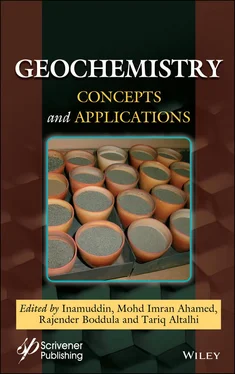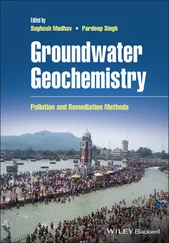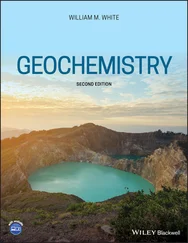Serpentinitic geological systems contain extremely high concentrations of toxic metals, specifically Fe, Ni, Cr, Co, Mn, and Zn [4, 27, 28]. The total concentrations of toxic metals have been reported to be in the order of hundreds and thousands mg per kg of dry soil. For example, the following total concentration of toxic metals was reported in serpentinitic geological systems in Albania: 3,865 mg Cr/kg, 3,579 mg Ni/kg, 2,495 mg Zn/kg, 1,107 mg Cu/kg, and 476 mg Co/kg [26]. High concentrations of toxic metals were also reported elsewhere in India and Zimbabwe [27]. Two points are noteworthy literature on toxic metals: (1) high total concentrations of Cr and Ni are considered universal in serpentines, but they co-occur with other toxic metals (e.g., Zn, Fe, and Mn) in equally high concentrations, and (2) the bulk of the data on toxic metals report total concentrations, which indicate the total pool in the soil, but provide no indication on the bioavailable and bioaccessible fractions [4]. The lack of data on bioavailable and bioaccessible concentrations makes it difficult to infer human health risks from such data. In some instances (e.g., Cr), some metal species (e.g., Cr (VI)) are more toxic than others (e.g., Cr(III)), but data on speciation are rarely provided in most studies on toxic metals.
The literature on metal geochemistry in serpentinitic geological environments is dominated by Cr, particularly Cr(VI), probably due to its high toxicity [4, 29]. Specifically, several studies exist on the role of Mn minerals (e.g., MnO 2, birnessite,) in accelerating the dissolution of Cr-bearing spinels such as chromite (FeCr 2O 4) and magnesiochromite (MgCr 2O 4), and the oxidation of Cr(III) to Cr(VI) [1, 30]. The accelerated dissolution and oxidation account for extremely high concentrations of Cr(VI) detected in aquatic ecosystem in serpentinitic geological systems [9, 29]. For instance, a recent review showed that high Cr(VI) concentrations above the World Health Organization (WHO) limit for drinking water (i.e., 50 μg L −1equivalent to 960 nM Cr(VI)) have been detected in both surface water and groundwater in several countries [4]. Such high concentrations may pose significant human health risks in cases where communities rely on untreated drinking water.
Unlike chrysotile, toxic metals may undergo uptake and bioaccumulation by wild plants and food crops. Rhizospheric processes including, root-soil interactions and the release of root exudates are critical in the biogeochemical behavior of toxic metals [4, 31]. For instance, root-soil interactions and root exudates may increase the bioavailability and bioaccesibility of toxic metals, and their subsequent uptake and bioaccumulation by plants and crops [31]. Such processes may transfer toxic metals from the soil system into the human food chain, thereby posing human health risks.
1.2.2.3 Rare Earth Elements
Rare earth elements are often excluded in literature on the geochemistry and medical geology of serpentinitic geological systems. Exceptions are cases where they are used as geochemical or environmental tracers [13]. Yet, evidence shows that rare earth elements may undergo enrichment in serpentinites such as peridotite and dunite, as well as their ultramafic protoliths [32, 33]. The enrichment of rare earth elements have been attributed to various processes occurring during the hydrothermal transformation [32, 34]. First, a decline in the solubility of rare earth elements is attributed to a rise in the pH of hydrothermal solutions during the transition from acidic to alkaline conditions after interacting with alkaline ultramafic rocks. Second, the interactions between the ultramafic rocks and hydrothermal fluids/melts and sea water rich in rare earth elements promote enrichment of rare earth elements. Therefore, rare earth elements may occur in high concentrations in serpentinitic geological systems, where they may undergo simultaneous release and dissemination with other toxic contaminants. The dissemination of rare earth elements may occur via contaminated sediments, and solid wastes and wastewaters from mining and mineral processing [4, 10, 35].
1.3 Human Exposure Pathways
1.3.1 Occupational Exposure
Toxic contaminants in serpentinitic geological systems may occur in various environmental compartments, including soils, wild plants, crops, and animals. Once in these environmental compartments, toxic contaminants may enter the human body via occupational and non-occupational exposure [4]. Occupational exposure to toxic contaminants may occur via inhalation in industrial production systems [36]. Typical industries promoting occupation exposure are: (1) mining and mineral processing, including quarries; (2) production of frictional materials such as brake pads, textiles, gas masks, cement, and asbestos; (3) agriculture; (4) construction; and (5) sculpturing, engraving, and carving [4, 37, 38]. Occupational exposure to chrysotile asbestos has been linked to human health risks such as kidney and ovarian cancers, respiratory diseases, and mesothelioma [38].
1.3.2 Non-Occupational Exposure Routes
1.3.2.1 Inhalation of Contaminated Particulates
Non-occupational exposure may occur via inhalation of contaminated air-borne particulates among populations living close to mining, construction, and agricultural activities [4]. For example, several abandoned chrysotile mines and waste dumps in Australia [39], South Africa [40], and Zimbabwe [41, 42], posing non-occupational exposure risks to communities. Non-occupational exposure may also occur via the transfer of toxic contaminants from clothes of workers to their family members.
1.3.2.2 Ingestion of Contaminated Geophagic Earths
The deliberate ingestion of geophagic earths such as clays and termite mounds, which is referred to as geophagy, may contribute to non-occupational exposure. Geophagy, which is practiced for various cultural and perceived health reasons, is common in several communities in Africa [10, 43]. For example, in Kenya, it is estimated that women consume 40 g per day of geophagic earths, contributing to iron intake of at least about nine times the maximum permissible daily intake [43]. High intake of toxic metals via geophagy has also been reported in other studies [44]. Although data pertaining to geophagy in serpentinitic geological systems are still missing, the intake of toxic contaminants could be higher in such environments compared to non-serpentinitic environments. This risk could be particularly higher among pregnant women and their unborn babies. This is because pregnant women have a high intake of geophagic earths, which is perceived to reduce anemia and nausea [45].
1.3.2.3 Ingestion of Contaminated Drinking Water
Toxic contaminants including chrysotile and toxic metals such as Cr and its highly toxic form Cr(VI) have been reported in aquatic systems in serpentinitic geological environments as early as the 1980s [46–48]. Cr(VI) exceeding the maximum permissible drinking water limit of 50 μg/L WHO [49] has also been detected in several aquatic systems, including groundwater, and surface water systems [50–52]. Thus, the consumption of untreated contaminated drinking water, a common practice in most developing countries may constitute a human exposure route to toxic contaminants.
1.3.2.4 Ingestion of Contaminated Medicinal Plants
Several herbal and medicinal plants have been reported to contain toxic metals exceeding permissible limits [4, 53]. For instance, a common medicinal plant (St. John’s Wort, Hypericum perforatum L.) growing on serpentinitic substrate had high concentrations of Cd, Ni, and Cr in dry plant material above the WHO permissible limits. Moreover, several medicinal and herbal plants in Africa (e.g., Senecio coronatus (Thunb.) and Datura metal L. (Solanaceae)) are known to be metallophytes and metal hyperaccumulators even under natural conditions [4, 54]. Hence, intake of herbal and medicinal plants constitutes a potential non-occupational exposure route especially for low income populations with limited access to modern health care.
Читать дальше



